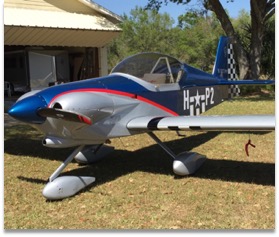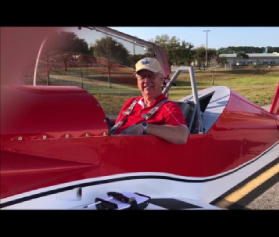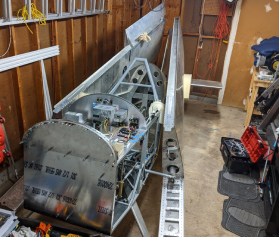We thought potential builders might like to see what an update from Dan looks like. Here is a recent email that went out to our builders on what we are doing, how things are going and what comes next. Plus a few photos….
Fiberglass
Last week the plugs for the canopy skirt (for the production canopy), tail intersection fairing and “universal cowl” were shipped to the composite shop. We were very pleased with how the Panther “Universal Cowling” plug came out. If you don’t remember what “FrankenCowling” looked like click HERE for a reminder on just how ugly it was when we started. A Lycoming O-320 and a UL are some wide decked engines to try and fit in the hood of a little Panther.




We also sent the canopy skirt off of the prototype, along with the tail intersection fairing.
Making plugs for these was VERY time consuming and slow. It took 5 weeks to do the cowl plug! For comparison: I made the original Corvair plug in 3-4 days! The difference was using epoxy resins which are VERY slow for me, and the fact that we have 50 builders at various stages who need various information, and parts… no lack of distractions going on here.
The composite shop estimates about 4 weeks from the time the parts arrive until they ship the first parts to us. For these parts to be released, we need to test fit them, etc.
Plan for Getting These Parts Ramped to Full Production
- Fit a production skirt on N515XP (the prototype) to verify basic fit. This includes using the new canopy rail and latch system as well as incorporating the “quick release option”. This allows the pilot to completely release the canopy by unlatching and pulling a pin release lanyard, allowing the canopy to totally depart the aircraft in the event that a parachute exit is needed. This isn’t really needed for many, but is mandatory per FAR part 23 on “aerobatic” aircraft. I always fly with a chute, and the quick release has been in the plan since the beginning. For guys who don’t wear a chute and/or don’t do acro or formation flying then the system allows almost instant canopy removal for maintenance access. This, combined with the ability to slide wing out of the way, and the removable forward upper skin (glare shield, bonnet, boot cowl… you pick what you want to call it) allows unparalleled access to the cockpit, behind the panel, wiring, controls etc.
- Fit a canopy on Paul’s airframe, which we think of as the production prototype. Other airframes are further along, but builders like Tony Spicer and Bob Woolley have forged ahead of us in areas to keep busy, so their parts do not reflect production parts or techniques in all areas. See notes on this below.
During this process we will document the canopy and skirt install with many photos and possibly some video to help make this typically frustrating and challenging part of aircraft construction easier. We have worked hard to come up with parts and procedures to do this and I think future builders will benefit greatly from it! More on this when the skirts arrive.
The company we are using for these items is a large firm who makes all the composite parts for the world’s largest kit plane producer… They have assured me they can get us caught up quickly to get the back order in check, and then build our stock! If you are waiting on “an entire kit to ship” like some of the out of country guys are doing, we may investigate shipping the kits ahead of the skirt and cowl to get you builders moving.
Documentation
We are still falling behind in the documentation department. I should say builders are out building us, but we designed an easy to build plane so it is our own fault.
Projected Plans Sheet Release Order
- Vertical and Horizontal tail install drawings are being finished now, for builders who have completed these
- Fuel tank
- Wing structure
- Wing skin (updated with more hinge info etc)
- Fuel tank install
- Tail finishing
- Wing finishing
- Forward fuse to aft mating
- Assembly and rigging as need
The forward fuse and assembly and rigging will likely be builders manual only as virtually no measuring etc. is needed. It is basically a bolt together affair. We may have a sheet on the forward upper skin and firewall.
We are using Paul’s airframe to document and test all parts so this is a slow process. If you need any information contact me and we will keep you building, if possible.
Note – be cautious if you are forging ahead of SPA documentation with your Panther project. Due to the nature of the information age there is a lot of information available that may not, necessarily, be accurate to the intended design or assembly process. Builder’s websites are a great asset to the builder community! But if you have any questions please contact us and we will be happy to walk you through.
Part Production Development
We are in the last stages of production development on parts. For welded parts we have push rod tubes, pushrod tube ends, wing fold pylon and wing fold universal joints to verify and produce
For aluminum we have the cheek skins, tunnel faring and tunnel sides. In the next week few weeks these parts will be in test fit and in full production. This, along with above canopy, will mark the end of a very long tooling process. (We are going to have a big party!)
As we wrap up these tasks we will start developing new features, such as the tri gear for the LSA version.
Construction VS Craftsmanship
A quick thought that keeps coming up: As I talk with builders I’m constantly reminded that we have builders of all experience levels, and more importantly, expectation levels. We have extremely skilled and experienced builders who just want it done quickly and be strong, with no real concern for the aesthetics of the finished product. To the polar opposite builder who has no experience, and wants an Oshkosh grand champion when finished. Then every type in between. There is nothing wrong with either mindset as long as you understand them and accept which type you are.
Construction Minded Builder
You accept the parts as they are, assemble, and move through the steps. This makes a safe and reasonably attractive airplane.
Craftsmanship Minded Builder
You assess each part for fit and finish and make small “tweaks” or adjustment to perfect the fit to the next part, then evaluate how this affects the next parts etc. You are constantly considering both the fit of this part and how it will affect the next. IE – how the rib fits into a spar channel, then making tiny adjustments to the rib and spar flanges so the skin will flow nicely across them. A real world example for ANY and EVERY kit I have built is the trailing rear spar channels. I use a 2×4 wood block with a band saw “slot” across the 4 inch direction to adjust the angles of the flanges so the skins will flow perfectly off the ribs and across the flange. It takes about 30 minutes to do this to each spar channel before skinning, and can make a big difference on the finished wings appearance (but with no measurable effect on safety or performance). If this type consideration is applied throughout the entire project excellent craftsmanship has been achieved.
No type is better, as long as you are OK with what type of work you are producing. It will be agony for some during building to take the extra time, while some will never be happy if they have any small flaws when completed (most of the time no one but the builder notices the flaw..…) The problem comes when you cannot accept the outcome of what type builder you are. Be realistic and purposeful in what type you want, or need to be, or you will turn an extremely satisfying project into a burdensome task.
Weight is the Enemy
We have builders starting to select engines and accessories so a few words are needed on this.
In all aircraft, but especially light aircraft, weight is the enemy. When choosing how to “equip” your Panther choose lightness! My Dad told me once while I was building a RC model
“if you toss a part in the air and it lands on the ground it is too heavy”
Think light and simple. The big areas that weight creeps in
- Engines
- Engine accessories
- Battery
- Wheels and brakes
- Tail wheel
- Paint
- Upholstery (side panel’s carpet etc.)
- Avionics
- Gadgetry
- Paint
- Modifications
OK – we all like big engines. If you must have an 0-320 then use the lightest form you can. Don’t settle for the “wrong” engine just because of pre-conceived ideas or what some guy has in the corner of a hangar at your field. I know we all have choices and compromises to make, but if you choose the heaviest wheels and brakes, the heaviest tail wheel, the heaviest engine, heavy avionics , etc. do not be surprised if you airplane is the heaviest!! (And don’t be shocked when you calculate useful, or not very useful, load ability)
NOTE – I want to reiterate that when considering large engines for the Panther Sport, it was designed for the conical mount, narrow deck 0-320s with the lightest accessories and wood props! If you are buying a new engine it will be a wide deck, but make sure it is a conical mount!
SPA Partners with Superior Air Parts
We have partnered with Superior Air Parts and are offering their full line of products. Superior’s XP320 is a good choice for the Panther Sport, or another project you may be working on. We can set you up with a running engine or a kit engine. We will be adding more parts and engine kits onto our webstore in the next months. If you need any Superior line of parts or pricing on an engine kit or a running engine please contact us!
On the horizon from SPA
- More OEM parts with updated web store for one stop shopping at competitive prices
- Testing the stroker 3.3 Corvair engine
- EIB (engine in box) development of kit engines for the Corvair based 3.3L and an ultra-light weight 0-320 based engine kit
- Cougar
- Permanent “Panther Cave facility”
As always feel free to contact us with questions or comments.
Thanks for your patience and continued enthusiasm.
– Dan Weseman



